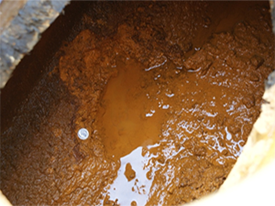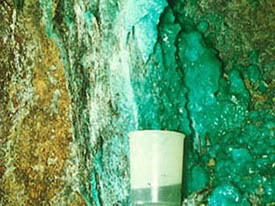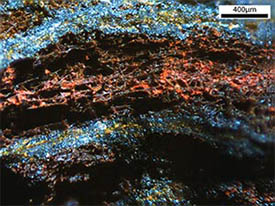Iron Mountain
Iron Mountain:An Extraordinary and Extreme Environment
PUBLIC LECTURE RECORDED JULY 26th, 2018: Iron Mountain, California: An Extreme Acid Mine Drainage Environment, presented by Charles Alpers, USGS Research Chemist
Pipe Scale Study

As acidic water at Iron Mountain is transported away from inactive mining sites to a treatment plant, microbial oxidation causes iron in the acid mine drainage to accumulate on the inside of the pipeline, resulting in pipe scale. The encrusted pipes interfere with treatment efforts and cause costly management problems when pipe-scale buildup clogs pipelines and other treatment structures. USGS scientists are working with the EPA to research strategies to prevent or retard scale formation in the pipeline.
Significance of Sulfates

Sulfide oxidation at Iron Mountain has led to extremely acid mine drainage and the active formation of a wide variety of iron-sulfate minerals, including phases identified on Mars. The presence of these sulfates has provided a unique opportunity for scientists to sample associated waters, evaluate water-mineral equilibria, and understand microbes living in these extreme conditions.
Connections to Mars Research

The mineralogy at Iron Mountain can serve as a proxy for understanding the formation of iron oxides and sulfates on Mars. The extreme conditions at Iron Mountain provide a unique setting that has allowed significant scientific advances to be made in environmental geochemistry, mineralogy, microbiology, and Mars analog studies.
